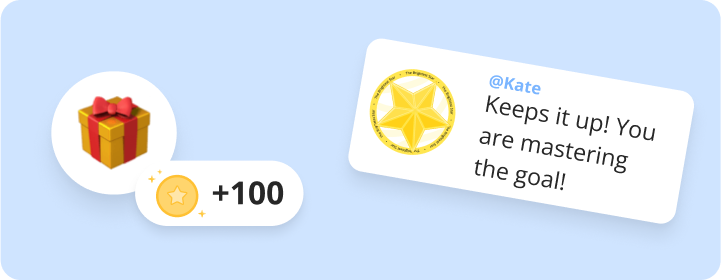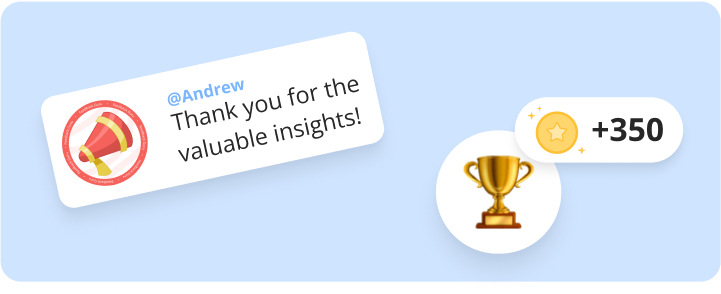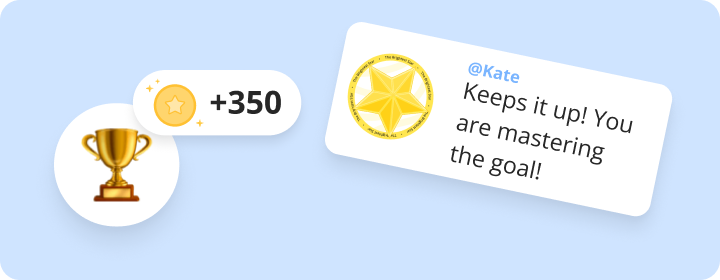HR Guide: How to Build a Reward Point System for Employees
Want to boost motivation and keep your team engaged?
A well-designed employee reward point system can do just that — turning everyday achievements into exciting incentives.
Whether you're aiming to improve productivity, morale, or retention, this guide will walk you through building and implementing a points-based program that's simple, scalable, and actually works.
🚀 Ready to create a culture of recognition that drives real results? Let's dive in.
What Is a Point System for Employees?
Let's start by defining an employee points system.
These schemes are gamified reward structures that allow employees to earn points based on their performance, achievements, or behaviours.
But these points are far from arbitrary.
Instead, employees can redeem their points for rewards such as gifts, recognition, or professional development opportunities.
🤔 So what's the point of, er, points?
The primary goal of a point system is to motivate employees by providing an engaging way to recognize their efforts.
Get this right, and you should be able to encourage positive behaviours, foster competition, and promote alignment with company goals.
Sounds pretty good, right?
What Makes a Great Employee Point Reward System?
So, you're sold on the myriad benefits of an employee point reward system.
But you won't reap all of these benefits without a highly effective employee recognition points program.
Indeed, a sub-par system could suffer from a lack of engagement or uptake and ultimately end up being a waste of budget.
So, how do you build an employee point reward system that's geared for success?
1. Clear Objectives and Metrics
A great point reward system starts with clear objectives and well-defined metrics.
Employees should know exactly what actions or achievements will earn them points.
For instance, meeting performance targets, completing tasks, attending events or embodying company values.
Not only do clear metrics make the system transparent and fair, but they empower leaders to swiftly identify issues within the scheme and tweak their strategies where necessary.

2. Balanced Difficulty and Reward
To be effective, the system must balance the difficulty of earning points with the value of those rewards.
This means assigning points based on task complexity, effort, or impact so that challenging tasks yield more points, incentivizing high performance.
So, while points should be given for achievable goals, they should also encourage employees to stretch their abilities.
Accumulated points can then be redeemed for rewards that match the effort.
Achieving the right balance should foster motivation, recognize contributions fairly, and encourage employees to take on both routine and ambitious work.
3. Real-time Feedback and Recognition
A pat on the back or a gentle steer in the right direction may not feel like much from a managerial perspective, but it can be huge for your employee.
Indeed, consistent feedback is crucial when it comes to keeping employees engaged.
And this is one of the principles that makes employee points reward programs successful.
An effective employee recognition points system provides real-time recognition of achievements, reinforcing positive behaviours instantly.
Incorporating feedback loops keeps employees motivated and invested in the system.
4. Personalization
Remember! A one-size-fits-all approach doesn't work for employee recognition.
This is because different employees are motivated by different types of rewards.
Some might only focus on monetary rewards, while others hope for career development opportunities.
Others will most appreciate simple, tangible rewards like extra paid time off, experience days, or gadgets.
It's vital to tailor rewards to individual preferences to achieve the desired effect.
If you're not one of life's best gifters, don't worry — you don't have to rely on guesswork.
Simply consult individual team members to find out their motivation before launching your rewards store.
5. Social and Collaborative Elements
Leaderboards, team-based challenges, and peer-to-peer recognition are crucial components of a great employee recognition point system.
These features foster a sense of community, encourage friendly competition, and promote social influence — all intrinsic motivators for many.
Step-by-Step: How to Build a Reward Point System for Employees
Ready to build and implement your point system for employee recognition?
You're only eight steps from success!
But remember — not every employee points system should look the same.
Your scheme must be tailored to your team's needs and aligned with your company's culture and goals.
Read on for a walkthrough of designing and implementing an effective employee reward system.

Step 1: Set Clear Objectives
Like with any project, setting objectives for your points system should be your first order of business.
This will give you purpose and focus as you design your system.
Start by thinking about your company's overarching goals and what your team could do better in order to contribute to achieving those objectives.
Also, consider the issues and challenges you must overcome within your team.
This should give you the basis for your objectives.
For example, perhaps you're trying to improve overall performance, increase engagement, or foster collaboration.
Step 2: Establish Performance Metrics
Once your objectives are in place, you must work out how to track progress towards those goals.
Your objectives should help you to determine the behaviours or actions that will be rewarded.
For example, if one of your overarching goals is to boost collaboration, you may want to track group project uptake or how many hours experienced colleagues are spending on mentoring.
If productivity is your primary focus, your performance metrics are more likely to surround completing projects, hitting deadlines, or achieving sales targets.
Make sure your metrics are clear, measurable, and achievable.
Step 3: Design the Reward System
Next, decide on the gamification principles of your reward system.
Of course, your system is going to centre around points.
But you can supercharge your scheme by adding more elements of gamification such as badges, tiers, streaks, or levels.
For example, your points could act as a form of currency, but to unlock a specific tier of rewards, you'd need to achieve a specific level.
Then, decide on your rewards, such as experiences, monetary bonuses, gift cards, gadgets, career development opportunities, public recognition, or social events.
Finally, nail down the specifics, such as how many points will equate to which type of reward.
Step 4: Incorporate Feedback Mechanisms
Feedback is at the heart of every employee points system.
Your scheme should provide timely, consistent and actionable feedback for every point earned.
This can be in the form of notifications, messages, or dashboards that let employees know how they are progressing.
This continuous feedback is essential for maintaining engagement.
Esteeme, for example, uses customizable badges to reflect company values.
These badges can be awarded publicly or privately by managers or colleagues and act as tangible symbols of achievement.

Step 5: Ensure Fairness and Transparency
Your points system must be equitable and transparent, or it risks making employees feel less valued than they currently do!
To ensure fairness and transparency in your points system, employees should understand how points are earned, tracked, and redeemed.
This means providing company-wide training on exactly how the scheme works and building it into your onboarding system.
Once your system is up and running, it's tempting to sit back and congratulate yourself on a job well done.
However, regular reviews of your points system are vital to ensure it motivates the right behaviours and provides a fair opportunity for all employees to earn rewards.
Step 6: Test and Iterate
You'll never create the best possible points system for your business on your first try.
This is why it's a good idea to start with a pilot program.
A pilot will show you how the point system is received by employees and allow you to iron out any kinks before your hard launch.
During your testing phase, gather qualitative and quantitative data and adjust your strategy based on what works, what doesn't, and what could be improved.
This iterative approach allows you to refine and optimize your points system over time to better meet employee needs and company goals.
Step 7: Promote the System
Widespread adoption and engagement are crucial if your points system is to work.
No matter how hard you push a new initiative, adoption can be lacklustre if employees aren't excited about it.
This is why creating awareness and excitement around your new point reward system for employees is so important.
Explain how it works, the benefits to employees, and how it aligns with company values.
And vitally — the prizes they could win!
Use communication platforms like email, Slack, or company-wide meetings to introduce the system, ensuring everyone is on board.
Step 8: Evaluate and Improve
Strategy adjustments and optimization don't have to stop once you're past the testing phase and have rolled out the points system to the whole company.
In fact, you should never stop evaluating your scheme and making improvements.
This gives your points system agility, allowing it to grow and change as your business does — and ultimately remain effective in the long term.
Set up a feedback process for employees to comment on the points system and schedule reviews of the system at regular intervals.
During these reviews, use the metrics you set up when designing your system to evaluate the impact of the employee rewards system on performance and engagement.
Look for areas to improve, whether by adjusting the rewards, refining the metrics, or enhancing the feedback mechanism.
Common Mistakes to Avoid in Employee Point Systems
When creating your points system for employees, it's important to sidestep these five pitfalls:

1. No Clarity On Rules Or Value Of Points
If you allow for confusion around your system's rules or point value, you'll foster confusion, mistrust, and disengagement within your workforce.
Aka, pretty much the opposite effect than the one you were aiming for.
Employees may feel the system is unfair or arbitrary — and who could blame them?
This is likely to result in reduced motivation and participation.
Clear guidelines ensure transparency, helping employees understand how to earn and redeem points, which boosts trust, accountability, and overall effectiveness of the system.
2. Too Complex To Manage Or Understand
A points system that's too complex to manage or understand can frustrate employees and administrators.
If tracking, calculating, or redeeming points is confusing, participation drops.
Employees may lose interest or feel overwhelmed while managers struggle to maintain it.
This is why, when creating your system, it's vital to think carefully about the user journey.
What exactly will your employees experience at every step of the points system, and how can you improve this experience and remove any friction from the journey?
Simplicity ensures engagement, consistency, and long-term success of the reward program.
3. Only Rewarding Top Performers (vs. Wide Participation)
Surely a points scheme should reward top performers?
Yes, absolutely — but it's crucial you don't forget about everyone else too.
Here's why.
A points system that only rewards top performers can demotivate the rest of the team, fostering resentment and reducing overall engagement.
And when recognition feels out of reach, employees may stop trying.
A balanced system should reward consistent effort and improvement, encourage participation from everyone and promote a more inclusive workplace culture.
4. Ignoring Feedback And Failing To Evolve The Program
Ignoring feedback and failing to evolve the points system can lead to stagnation and dissatisfaction.
Employees' needs and workplace dynamics change over time.
This means that without updates, the system may become irrelevant or unfair.
Regularly reviewing and adapting the program ensures it stays effective, motivating, and aligned with employee and company goals.
5. Not Integrating It Into Everyday Tools/Workflow
If a points system isn't integrated into everyday tools or workflows, it feels disconnected and is easily forgotten.
If accessing the points scheme requires extra work, employees may overlook opportunities to earn points or find the system burdensome.
This means all your hard work is going to waste, and you're unlikely to see many benefits from implementing an effective employee points reward system.
Instead, aim for seamless integration.
This ensures visibility, ease of use, and consistent engagement, making the program a natural, effective part of daily work routines.
How Esteeme Helps You Build a Scalable Point Reward System
Employee recognition and rewards software Esteeme is redefining recognition through a gamified experience that balances employee motivation with business efficiency.
Its game economy is designed for your business needs, delivering more value for less expense.
It achieves this through:
✅ A custom coefficient: Esteeme calculates a tailored conversion rate between your local currency and virtual coins to ensure your budget is optimized for engagement without overspending.
✅ Balanced Value: Each coin spent by an employee is meticulously calculated to reflect both the value of their achievement and the company's financial limits.
✅ Real Savings: By offering virtual rewards with high perceived value, your employees feel appreciated without stretching your budget.
✅ Flexible Coefficient for Items: it is very easy for the admins to adjust the coefficient for specific items and make them cheaper in coins, thus, more achievable for the user but of less value to the business.

⬇️ Here's an example.
Instead of directly purchasing an item worth $50, employees redeem coins earned through recognition, which might translate to just $30 of your budget — while still delivering a $50 experience.
This game economy makes designing your points system super straightforward.
Other Esteeme highlights that help you to create a seamless employee point system include:
✅ A fully customizable coin-based system
✅ Peer-to-peer recognition with badges and coins
✅ Create automated campaigns and events with point milestones
✅ Reward store with custom items and no-cost perks
✅ Real-time dashboards and analytics for tracking and optimization
✅ Slack/Teams integrations for seamless day-to-day usage
Conclusion
A well-built employee point reward system boosts engagement, motivation, and culture.
The key to getting rewards and recognition right?
Simplicity, clarity, fun, and personalization.
Esteeme makes it super easy to launch and scale your own gamified reward program.
🚨Book a demo to see Esteeme's employee points rewards system in action
FAQs
- An employee reward point system is a structured method to track performance, attendance, or behaviour by assigning points for specific actions, such as attending training or events or completing tasks. Accumulated points can lead to recognition and tangible, real-world rewards. It helps maintain accountability, encourages consistency, increases productivity, enhances engagement, boosts employee satisfaction, and promotes a fair and positive work environment.
- To create an employee points reward system, first, invest in a gamified employee recognition platform such as Esteeme. This will ensure your employee points reward system runs smoothly and successfully engages your workforce. Next, define clear behaviours or achievements that earn points — like completing tasks, attending events, punctuality, sales goals, or teamwork. Then, set your system up in Esteeme. Finally, ensure transparency, regularly update rewards, and get employee feedback to keep the system engaging and fair.
- The best rewards in a points-based program are those that motivate and appeal to your team. This is why it's helpful to consult your team on their interests and motivations before launching your points-based rewards system. Popular options include gift cards, extra time off, bonuses, public recognition, professional development opportunities, and company swag — a mixture of paid-for and free rewards. Offering a variety of choices in a shop format ensures employees feel valued and can pick rewards that suit their preferences.
- Esteeme enhances employee reward point systems through gamification, allowing employees to earn coins and badges for participating in various activities and achieving milestones. These coins can be redeemed in a customizable gift store, offering rewards that align with company values. The platform also features leaderboards, badges and personalized profiles for your recognition program to boost engagement and morale. Additionally, Esteeme's game economy ensures balanced rewards and effective budget management, providing valuable insights into employee engagement and spending.







